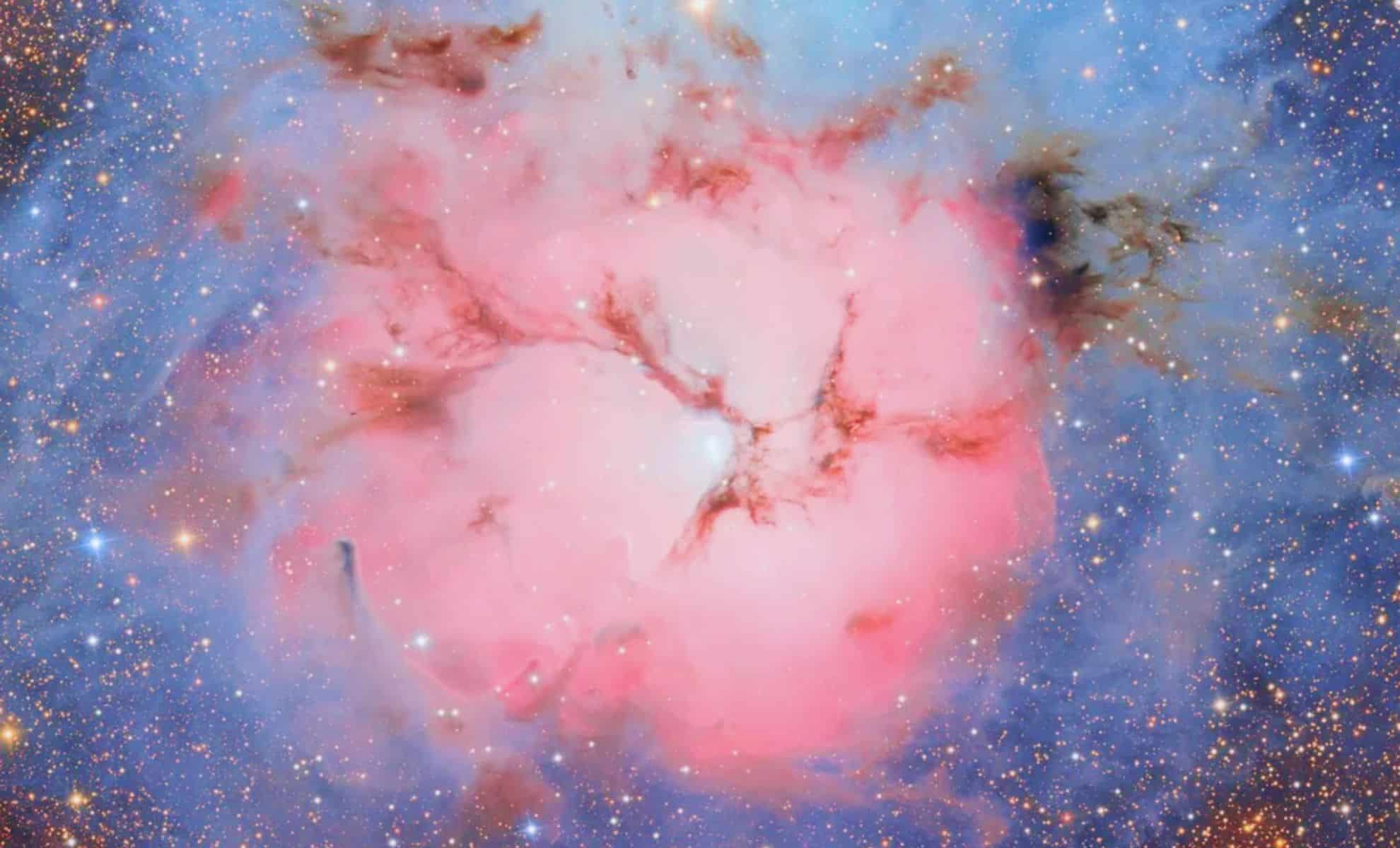The Vera C. Rubin Observatory has unveiled its first close-up image of the cosmos, offering an extraordinary new perspective on the Trifid Nebula (Messier 20), located 5,000 light-years away in the constellation Sagittarius. This stunning new image, shared in June 2025, comes from the observatory’s groundbreaking Legacy Survey of Space and Time (LSST) Camera, which is capable of capturing the most detailed images of space ever recorded.
The image, a product of 664 individual exposures over four nights in May 2025, captures the nebula’s intricate structures and vibrant colors—ranging from a deep pink to a soft blue—each color revealing different aspects of the nebula’s composition. The dazzling clarity of this image is expected to become a cornerstone for future astronomical studies, as the Rubin Observatory embarks on a decade-long mission to map the Southern Hemisphere’s night sky. The detailed view of the Trifid Nebula is only the beginning, as the observatory will continue to unveil groundbreaking discoveries about the universe.
The Trifid Nebula: A Cosmic Work of Art
The Trifid Nebula is known for its unique appearance and the way its three parts seem to split the nebula into intricate sections. This “split” nature, highlighted in the image, is what gives the nebula its name—Trifid, meaning “three-lobed” in Latin. The nebula is a cosmic cloud of gas and dust that plays a key role in star formation, making it a subject of intense interest for astronomers.
The pink regions of the image represent an emission nebula, where ionized gas emits its own light due to the energetic radiation from newly formed stars. In contrast, the blue regions are classified as reflection nebulae, where light from nearby stars is scattered by dust particles, creating a glowing effect akin to streetlights on foggy nights.
The nebula also features darker regions, which represent dark nebulae and dust lanes that act as barriers to light, adding to the nebula’s complex structure. These lanes divide the nebula into three distinct parts, which are visible in high resolution in the new image from the Vera C. Rubin Observatory. Within these sections, star formation is actively taking place, driven by the intense radiation and gravitational forces within the nebula. These newly born stars not only illuminate the nebula but also sculpt its surrounding gas and dust, creating the visually stunning patterns seen in the image.
How the Vera C. Rubin Observatory Will Revolutionize Astronomy
The Vera C. Rubin Observatory, based in Chile, is equipped with the world’s largest digital camera, designed to capture high-resolution images of the sky with unprecedented speed. The LSST Camera, with a 3,200-megapixel resolution, enables the observatory to image large portions of the sky every three to four days. This ability will allow scientists to create an incredibly detailed and time-sensitive survey of the universe.
Over the next decade, the observatory is expected to gather more data in a single year than has ever been collected by all prior optical astronomy combined. The observatory’s ongoing mission is not only focused on deep space objects like the Trifid Nebula, but it also aims to identify previously unknown asteroids, supernovas, and potentially hazardous near-Earth objects.
Already, in its first week of operation, more than 2,100 new asteroids were discovered, highlighting the immense potential of this new tool in the search for celestial bodies that could impact Earth.
Each patch of sky imaged by the observatory will be revisited up to 800 times, ensuring that no cosmic event goes unnoticed, and providing a real-time survey of astronomical phenomena across the Southern Hemisphere.
A New Era of Space Exploration
The unveiling of the Trifid Nebula is only the first chapter in what promises to be an exciting era for space exploration. The Vera C. Rubin Observatory is paving the way for new discoveries that will reshape our understanding of the universe. The observatory’s ten-year survey will focus on uncovering answers to some of the biggest questions in modern astronomy, such as the nature of dark matter, the origins of cosmic phenomena, and the identification of new celestial bodies.
With its highly advanced imaging technology, the observatory will also be instrumental in tracking the trajectories of near-Earth objects (NEOs), allowing scientists to better predict the potential risks posed by asteroids and comets. The discoveries made by the Rubin Observatory will be integral to the future of space exploration, as they help researchers monitor and understand the objects that could affect Earth.
Exploring the Universe with the LSST Camera
The LSST Camera aboard the Simonyi Survey Telescope is the heart of the Rubin Observatory’s impressive capabilities. This digital marvel is equipped to capture extremely detailed images of the night sky, enabling researchers to detect objects that were once invisible to traditional telescopes. The sheer size of the LSST Camera’s field of view allows it to image vast sections of the sky in a short period of time, making it one of the most powerful astronomical tools in existence today.
The Trifid Nebula, captured in exquisite detail by this camera, is just one example of the astonishing imagery the Rubin Observatory can produce. These images will help astronomers study celestial objects over time, tracking their evolution and behaviors in ways never before possible.
With this technological leap, the Rubin Observatory is set to significantly expand our knowledge of the universe. By creating a comprehensive, time-lapse survey of the sky, the observatory will provide a wealth of data on a variety of cosmic phenomena, from the birth of stars to the movement of distant galaxies. As the observatory continues its work over the next decade, it will undoubtedly make major contributions to both our understanding of space and the safety of our planet.
